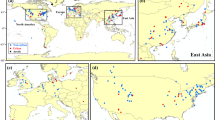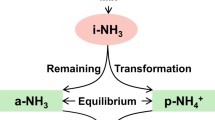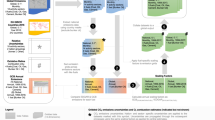Abstract
While approximately 7.5 × 1012 grams (7.5 Tg) of combustion nitrogen are emitted yearly in the United States and Canada1–3, only 1.5–2.3 Tg are deposited as acid rain over that same region4–6. Past nitrogen budget estimates4,10 as well as recent observations11 suggest that dry deposition and export play major roles. Here we report how the yearly accumulated deposition and transport of combustion nitrogen is simulated for the first time by a global transport model with realistic meteorology. The model predicts that dry deposition over the United States and Canada accounts for at least 2.1 and most probably 3.5 Tg of the emissions. The remainder is exported, principally over the North Atlantic. But at most 0.2 Tg, less than 3% of the estimated European emissions4, is predicted to reach Europe from North America. Furthermore, the model predicts that, while less than 40% of the nitrogen deposited as acid rain in the northeastern United States and eastern Canada comes from emissions in that region, almost all of the dry-deposited nitrogen and over half of the total acid nitrogen deposition comes from there.
This is a preview of subscription content, access via your institution
Access options
Subscribe to this journal
Receive 51 print issues and online access
$199.00 per year
only $3.90 per issue
Buy this article
- Purchase on Springer Link
- Instant access to full article PDF
Prices may be subject to local taxes which are calculated during checkout
Similar content being viewed by others
Author information
Authors and Affiliations
Rights and permissions
About this article
Cite this article
Levy II, H., Moxim, W. Fate of US and Canadian combustion nitrogen emissions. Nature 328, 414–416 (1987). https://doi.org/10.1038/328414a0
Received:
Accepted:
Issue Date:
DOI: https://doi.org/10.1038/328414a0
This article is cited by
-
Impacts of typical rainfall processes on nitrogen in typical rainfield of black soil region in Northeast China
Arabian Journal of Geosciences (2015)
-
Comparison of oceanic and continental sources of non-sea-salt sulphate over the Pacific Ocean
Nature (1989)
-
Influence of long-range transport of combustion emissions on the chemical variability of the background atmosphere
Nature (1989)
-
Influence of atmospheric pollution on nutrient limitation in the ocean
Nature (1989)
-
Nitrate in the atmospheric boundary layer of the tropical South Pacific: Implications regarding sources and transport
Journal of Atmospheric Chemistry (1989)
Comments
By submitting a comment you agree to abide by our Terms and Community Guidelines. If you find something abusive or that does not comply with our terms or guidelines please flag it as inappropriate.



